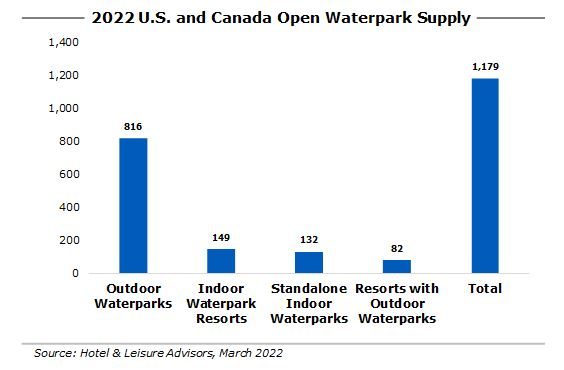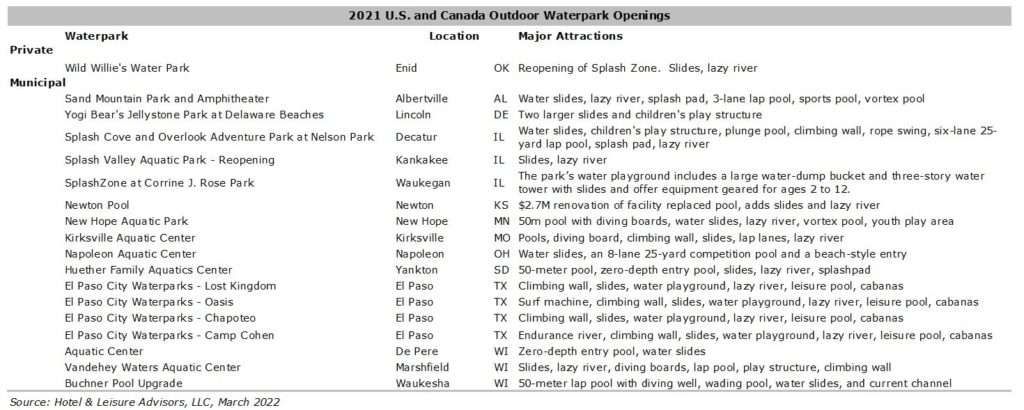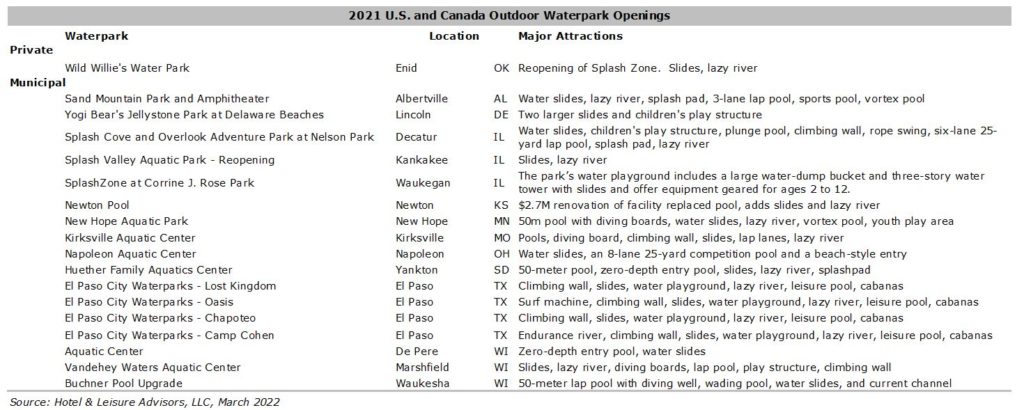Waterparks Riding a Recovery Wave in 2022
After two years of pandemic concerns that saw many waterparks remain closed throughout 2020 and suffer continued disruption in 2021, 2022 is anticipated to be a pivot back to normal for the industry. As vaccines are now widely available and COVID becomes endemic, waterparks are poised to capitalize on pent-up demand and return to pre-COVID performance levels. While 2021 saw robust growth in pricing at many properties, 2022 will see the industry open a number of expansions and new developments. Several large-scale projects will alter the waterpark landscape at both indoor and outdoor waterparks and continue to encourage properties to innovate and update to keep market share. A number of larger developments are planned for 2023 and beyond at waterparks and surf parks throughout North America.
Attendance at waterparks in 2021 was down overall due to COVID-19 concerns that imposed capacity constraints at many waterparks. However, most waterparks were able to increase their prices, and they expect to maintain these higher prices in 2022. Consequently, as attendance returns to pre-pandemic levels, we expect increases in total revenues at many properties.
While 2022 looks as though it will be the first “normal” year for waterparks since 2019, the industry will still face challenges. Factors such as higher wages and prices, inflation and lingering pandemic effects will impact the industry in 2022.
CURRENT WATERPARK STANDINGS FOR THE U.S. AND CANADA
As of March 2022, the United States and Canada had a total of 1,177 waterparks. Thirty of those properties opened in 2021, while four properties closed. More than half of these openings were in the outdoor standalone segment, with one new private facility and seventeen new municipal/non-profit facilities. Ten indoor waterparks and resorts opened in 2021, including seven indoor standalone waterparks, one private and two municipal.
The following bullets break down the numbers regionally for all waterparks in the U.S. and Canada:
- The Midwest and South are home to the most waterparks, with 418 and 389, respectively.
- The Midwest has pulled even with the South in total number of outdoor waterparks with 299 each, while Canada has the fewest at 33. Outdoor waterparks in the South typically have slightly longer operating seasons than those in the Northeast and Midwest due to more favorable weather conditions.
- The Midwest leads the U.S. and Canada in indoor waterpark resorts by a large margin with 80.
- The West leads in standalone indoor waterparks with 47, primarily due to the large number of municipal/non-profit indoor aquatic facilities with waterparks in Colorado and Utah.
- The South leads in resorts with outdoor waterparks with 49.
- Indoor waterparks account for a greater proportion of the Canadian market with 39 indoor resort and standalone facilities. Outdoor waterparks have held steady at 33.
- Of all hotels with indoor and outdoor waterparks, 44 percent are affiliated with national hotel franchises while 56 percent are independent.
- Of all standalone indoor and outdoor waterparks, 69 percent are municipal/non-profit while 32 percent are private/for-profit.
The following chart shows the breakdown of waterpark properties by type out of the 1,178 waterparks in existence:
REVIEW OF 2021 NEW OPENINGS AND EXPANSIONS
Indoor Waterpark Openings: In 2021, ten indoor waterpark additions or expansions added 343,710 square feet of indoor waterpark space compared to 625,200 square feet in 2020. 2020 benefited from two large additions: the 225,000-square-foot DreamWorks Waterpark at American Dream Mall in East Rutherford, New Jersey, and the 223,000-square-foot Kalahari Resort in Round Rock, Texas. No properties of this size opened in 2021.
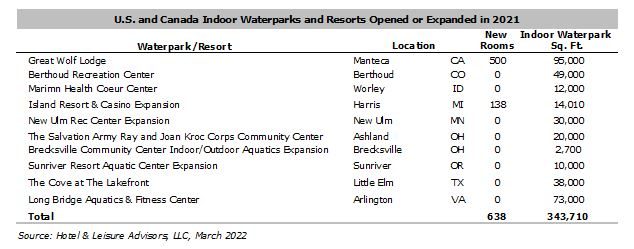 The number of new resort rooms in 2021 was down from 2020, which gained 975 rooms due to the opening of the Kalahari Resort in Round Rock. The most significant project opening in 2021 was the Great Wolf Lodge in Manteca, California. The 500-room resort features a 95,000-square-foot indoor waterpark and a 45,000-square-foot adventure park, which includes a ropes course, miniature golf, arcade and a high-tech, newly imagined version of the brand’s exclusive MagiQuest interactive adventure game.
The number of new resort rooms in 2021 was down from 2020, which gained 975 rooms due to the opening of the Kalahari Resort in Round Rock. The most significant project opening in 2021 was the Great Wolf Lodge in Manteca, California. The 500-room resort features a 95,000-square-foot indoor waterpark and a 45,000-square-foot adventure park, which includes a ropes course, miniature golf, arcade and a high-tech, newly imagined version of the brand’s exclusive MagiQuest interactive adventure game.
Outdoor Waterpark Openings: Due to the COVID-19 pandemic, many municipal waterparks that were scheduled to open in 2020 were postponed until 2021. Consequently, 18 standalone outdoor waterparks opened in 2021.
The city of El Paso, Texas led the way in waterpark openings in 2021 with four new outdoor waterparks at various sites throughout the city with amenities ranging from leisure pools and “lazy” rivers to a surf machine, slides and water playgrounds.
Resorts with Outdoor Waterparks Openings: With only five openings or expansions, resorts with outdoor waterparks had the smallest number of additions in 2021, but still outpaced results from 2020.
In addition to the U.S. properties shown above, in the Bahamas, Baha Mar Resort in Nassau added the $200 million Baha Bay outdoor waterpark adjacent to the SLS and Melia Hotels. The well-themed waterpark opened in July 2021 and includes a wide range of rides and attractions. It is one of the most expensive waterparks to open in North America.
All U.S. Openings:
The following map highlights the locations of the 2021 indoor and outdoor waterpark openings in the U.S. inclusive of resorts and standalone properties.
 2021 saw four waterpark closures, including Splashtown San Antonio in San Antonio, Texas, and the CoCo Key Water Resort in Omaha, Nebraska.
2021 saw four waterpark closures, including Splashtown San Antonio in San Antonio, Texas, and the CoCo Key Water Resort in Omaha, Nebraska.
COVID-19 IMPACT AND OTHER ECONOMIC REALITIES
While 2022 started off rocky with COVID-19 infection rates soaring in many parts of the country, recent data indicates that the pandemic will quickly transition to endemic, with restrictions in most states being lifted as we return to normalcy. This transition is expected to have a positive effect on all industries, with waterparks poised to gain back demand lost in 2020 and 2021. However, though pandemic concerns will likely ease, there are lingering economic and operational effects that will continue to impact the industry as it moves to a full recovery. Inflation, increases in wages and the labor shortage will all impact operations in 2022.
- Labor Shortage: As seen across many industries throughout 2021, the national labor shortage affected and will continue to affect the waterpark industry throughout the country in 2022. As industries reopened, waterparks and leisure properties were forced to staff quickly. This, combined with the many former workers still reluctant to get back into the roles they once had, caused shortages across all segments.
- Wage Increases: In part due to the labor shortage, wages and salaries grew by 4.7 percent in 2021. However, hospitality and leisure industry wages and salaries grew by 6.8 percent, an increase from 4.1 percent in 2020, according to the Bureau of Labor Statistics. Labor shortages have forced many waterpark and leisure properties to increase wages as they compete for workers. As an example, Schlitterbahn waterparks in Texas are advertising positions starting as high as $17 per hour, a substantial increase from pre-COVID-19 levels.
- Inflation Concerns: The cost of nearly everything went up in 2021, which poses concerns for waterpark operators. As of January 2022, the U.S. inflation rate clocked in at 7.5 percent, a substantial increase from previous years. As the costs of food and beverage, labor, energy and materials continues to increase, waterparks have to either absorb those costs and risk profits or pass those costs on to consumers in the form of higher admission rates.
- Added Benefits: With labor tight, operators are looking for new ways to retain employees by adding benefits. Herschend Family Entertainment, the nation’s largest privately-owned themed attraction corporation, is offering to cover the cost of tuition, fees and books for employees who wish to further their education. These types of benefits could help properties by encouraging employees to remain on the job longer term as they work through their classes.
- Consolidation: SeaWorld recently made a bid to acquire Cedar Fair, which would have created the largest operators of waterparks and related attractions in the United States. However, it was rejected as of the date of our research for this article.
- Higher Pricing: Most waterparks increased their prices in 2021 due to inflationary pressures, higher wage rates and reduced capacity due to COVID-related concerns. Managers we have interviewed indicated that they expect higher prices to continue into 2022, which should allow for higher per capita spending and total revenue at most waterparks.
PROJECTIONS FOR 2022
For 2022, we will see growth across all segments of the waterpark industry with projected openings of 20 facilities. We also anticipate expansions of more than 31 existing facilities. Regionally, the South leads the U.S. with 13 projected openings. The Midwest will see six openings, and the West one. As of this writing, no major openings or expansions are anticipated for the Northeast. Overall, the number of projected openings is down from 2021. The following map highlights the locations of the properties.
Indoor Waterparks: With projections of 232,500 square feet of new indoor waterpark space and over 330 new rooms, 2022 will be a year of continued growth in this market segment.
- OWA’s amusement park, The Park at OWA, in Foley, Alabama, will open a 100,000-square-foot indoor waterpark and a family-friendly RV park as part of its $100 million Phase II expansion project. An accompanying 200-room resort hotel with conference space will open in 2023.
- As part of a multi-sports complex in Goddard, Kansas, the Goddard Aquatic Center and Genesis Health Club is adding the 60,000-square-foot Blast Off Bay indoor waterpark and natatorium and a connected 133-room, four-story Hampton Inn hotel.
Beyond 2022, Great Wolf Lodge is constructing a 700-room property in Perrysville, Maryland, which will open in 2023, and has announced plans for new resorts in Texas, Tennessee, California and Connecticut, making it one of the most growth-oriented companies in the indoor waterpark resort space.
Outdoor Waterparks: Growth in the outdoor segment will continue with 19 new standalone waterparks anticipated. Many existing waterparks are investing in modest to large expansions in 2022. Highlights include the following:
- The largest of these outdoor waterpark developments is Wild Rivers Waterpark, which will return to the city of Irvine, California after more than a decade. The original park operated from 1986 until its closure in 2011. The new, 26-acre, $60 million park is located in Irvine’s Great Park and will be leased to operator Mike Riedel.
- Tampa’s Adventure Island will debut the “Wahoo Remix,” a family raft ride featuring synchronized light and sound elements, and “Rapids Racer,” the world’s first dueling saucer through tunnels and high-speed turns.
Resorts with Outdoor Waterparks: There are four planned expansions or new developments of resorts with outdoor waterparks in the United States in 2022. Highlights include the following:
- The 550-unit Landmark Resort is developing a $3 million outdoor waterpark set to open in the summer of 2022. The 9,800-square-foot outdoor facility will feature slides and water play features.
- A $175 million renovation is under way at The Boca Raton resort in Boca Raton, Florida. The updates include the Harborside Pool Club, which will feature cabanas, pools, a leisure river, five-story waterslides and a kids’ splash zone.
Surf Innovations: New innovations continue to be developed for the waterpark industry including multiple new man-made surfing facilities. The leading companies in this space include Wavegarden, Citywave, American Wave Machines, Surf Lakes and SurfLoch/WaveLoch. We expect to see additional opportunities for consumers to enjoy surfing on artificial waves in the coming years as developers work to construct multiple projects.
Surf parks appeal to a wide range of customers in various life stages, including families with children. Surf parks can capitalize on that in much the same way waterparks have by creating family-friendly environments coupled with memorable experiences. This will increase the reach and scope of the sport in a way that may lead to dramatic growth in coming years.
Surf parks have strong developer interest in North America and throughout the world. The following table shows the number of surf parks proposed or under construction . These do not include projects in very preliminary stages.
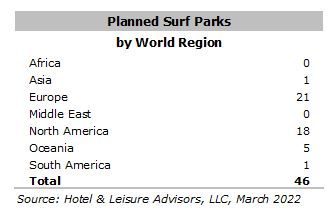 The United States could see five new surf parks open in 2022.
The United States could see five new surf parks open in 2022.
The Palm Springs Surf Club is performing a $50 million redevelopment of the former Wet ‘n’ Wild waterpark in Palm Springs, California. The project will feature a three-million-gallon, state-of-the-art Surf Loch technology wave pool. The developers have transformed an existing pool with large-wave-making technology which will be open to the public. Other planned amenities include a leisure river and restaurant.
CONCLUSION
After two years of uncertainty, the waterpark industry is poised to splash into 2022 operating from a place of strength. Many indoor waterpark resorts outperformed traditional hotels during the past 12 months due to their strong demand from leisure families. Leisure demand actually grew during the pandemic in contrast to the group and corporate segments, providing a boon to properties with lodging components. There are new waterpark resorts proposed and under construction throughout the United States with Great Wolf Lodge leading the way with multiple new projects. New standalone waterpark projects are also projected to open both indoor and outdoor by municipal and private developers. As the market remains strong for development, financing challenges, inflation and labor costs will remain a concern and may dampen some opportunities.
However, as much as the pandemic forced the industry to adapt, fundamentals of waterparks remain strong, and we expect to see continued growth. With a couple of tough years seemingly behind us, owners, operators and developers can take the lessons learned and challenges faced into the recovery with renewed hope and perspective. While the waterpark industry has not changed in essentials, we are excited to see further innovation and adaptation as the industry gets back to the basics of entertainment and immersive fun on the road to a robust recovery.

